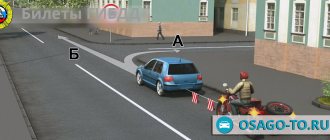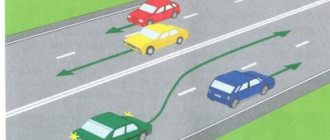General rules for towing a trailer hitch
Motorists often travel with trailers at speeds of 140 km/h. Which is not acceptable, but unfortunately happens. Manufacturers recommend sticking to speeds of up to 100 km/h. Decoding the traffic rules looks like this:
- When driving on a motorway without a towed device, the speed limit is 110 km/h. With a trailer, the maximum speed is no higher than 90.
- On other roads outside populated areas without a trailer - 90 km/h, with a trailer - 70 km/h.
- In populated areas, the traffic limit for all vehicles is 60 km/h.
The fine for speeding varies from 500 to 5000 rubles. As well as deprivation of a driver’s license from 4 to 6 months for the first incident and up to 1 year for a second incident, if the violation for speeding is 60-80 km/h. According to traffic regulations, it is prohibited to transport passengers in a trailer, semi-trailer, or caravan trailer. It is prohibited to drive a road train without connecting electrical devices of the trailer to the vehicle, trailer hitch and safety cables. The road sign “driving with a trailer is prohibited” prohibits the movement only of trucks over 3.5 tons, tractors, and self-propelled vehicles.
On the rules for driving vehicles with a trailer as part of a road train
Each owner of a towed vehicle (vehicle), when purchasing this mechanism, knows or assumes for what purpose it will be used.
Traffic legislation provides standards and rules that every driver who gets behind the wheel of a car with a trailer must comply with.
The main concepts include the following:
- A trailer is a vehicle that does not have its own engine and can only be moved on roads when accompanied by a moving mechanical vehicle;
- A coupled trailed vehicle and a mechanical vehicle is considered a road train.
Each driver, when driving as part of a road train, must have the necessary set of documents for vehicles, a driver’s license with the appropriate permitted category of driving when driving a trailer, and an insurance certificate in cases specified by law.
If requested by a traffic police officer, present the entire set of documents. In order to ensure compliance with traffic rules on the road, before leaving, the driver is obliged to check the technical condition and serviceability of the towed vehicle, make sure that the lighting and braking devices are working, and check the reliability of the connection of the hitch and the safety cable.
It should be remembered that the driver is prohibited from using a tow hitch with a faulty braking system, with inoperative dimensions, a malfunction in the coupling mechanism, a safety connection, or in poor or limited visibility on the road.
The basic rules when driving with a trailer on the roads include the following:
- Maximum speed with a trailer, compliance with the speed limit when driving on various sections of the road in populated areas and outside populated areas;
- Compliance with the rules when transporting goods in a trailer: overtaking, braking, stopping;
- Ensuring reliable securing of cargo, distribution of the center of gravity of the cargo on the trailer;
- Availability of necessary documents for a trailer, car, driver's documents;
- Use the trailer only for its intended purpose, registered with the State Traffic Safety Inspectorate. Transporting people in a trailer is prohibited.
Rules for avoiding trailer skidding
Driving pattern when turning with a trailer
When turning or bending the road, pressing too hard to the left edge of your lane will fold the trailer in half. Such a trip to the country results in dents on the car, deformation of the trailer fender, and loss of cargo. In fact, the turning arc of a vehicle with a towed device is wider. Therefore, when turning, you should leave more lateral space. That is, if you turn left, you need to go in an arc to the right. And vice versa. But if there is a skid, the trailer overturns.
The most common mistake is braking while turning. But the trailer does not like this and does not forgive. You need to take turns with a towed device at a stable speed, without reducing or increasing it, otherwise it will drag the car to the side.
The picture becomes clearer: you need to slow down and turn.
But what to do if the trailer still starts to sway from side to side? It's simple, you just need to add speed:
- Enter the turn.
- Press the gas pedal. There will be no skidding.
Current speed limits for cars
First, let's talk about the current permitted speeds at which category B vehicles can move. That is, ordinary passenger cars.
The restriction directly depends on the location, the road along which the traffic is carried out. Therefore, there are 3 categories here.
Please note that they do not apply to a vehicle with a trailer.
- In the city. If the car moves inside the city, then the speedometer needle should not be allowed to go beyond the 60 kilometers per hour mark;
- In the country. But outside the populated area, slightly different restrictions apply. Here, passenger vehicles are allowed to increase the limit, and the maximum speed will be 90 kilometers per hour;
- On the motorway. When driving on the highway and highways, drivers are given considerable freedom, which is limited at around 110 kilometers per hour.
The logic behind such restrictions is extremely clear. There is a larger concentration of vehicles and pedestrians inside populated areas than outside the city.
And the more traffic participants, the higher the likelihood of various types of emergency situations. Therefore, it is quite natural that in such areas the speed is limited more, forcing drivers to drive slower.
When leaving the city, the situation changes. There are fewer cars, the traffic density decreases, there are practically no pedestrians, and the road mostly involves moving in a straight line. That is, the driver is not required to perform a large number of maneuvers, driving the vehicle is easier, as is controlling the situation. Highways are specially designed to allow cars to travel quickly. At the same time, the highways have one interesting feature. It lies in the fact that speed restrictions exist not only in the upper, but also in the lower limit.
What am I talking about? Everything is elementary. Highways allow for fast travel. Unlike the city, where fast cars pose a danger, here the situation is the opposite. Slow moving vehicles are considered dangerous. Therefore, vehicles whose speed is less than 40 kilometers per hour are not allowed to enter the highway. Roughly speaking, you won’t be able to take a walk-behind tractor to tow a trailer and drive it along the highway. There is a fine for this.
Reverse parking rules
Manual installation into a parking space is suitable when parking with a car is excluded due to load capacity or lack of turning. It's not that easy to park in reverse with a trailer. To do this, you need to break the trajectory of the trailer. If the gate is on the left, then the first action should be “steer to the right.” Then the rear bumper goes to the right and the trailer to the left. Then turning the steering wheel in the opposite direction will ensure movement in a smooth arc. If you turn the steering wheel a lot, the road train will fold. To prevent this from happening, you need to turn the steering wheel faster.
A general rule for all drivers: you cannot start driving a trailer in reverse if the situation behind the towed vehicle is unknown. The assistance of a partner is often necessary to control maneuvering.
Preparation
- Before driving (lifting) the car onto the platform, make sure that the trailer is in good condition and that the fasteners and accessories used are strong and intact!
- Do not forget to make sure that the car transporter is suitable for the cargo in terms of size and weight. Yes, the same LAV 81021 from with its load capacity of 2550 kg, in theory, covers almost the entire range of passenger cars, but still.
- Position the car transporter trailer as level and convenient as possible for loading. If this is not done, the load vector will change in movement and the fastening will weaken
After everything is ready, lift the car onto the platform using the access ramps, and if it is impossible to enter on your own, use a winch, manipulator or crane. In this case, the car should be positioned so that the load on the trailer axles diverges approximately evenly. That is, no displacements to the sides and front-rear edges; marks and support posts will help you with this.
- Having positioned the car, prepare it for transportation:
- Close the windows, doors, hood and trunk lids, and the roof hatch if equipped.
- Move the windshield wipers to the zero position, turn off power consumption
- Secure the car with the hand (parking) brake and put it in gear; if it is an automatic transmission, move the lever to o
- Remove the keys from the ignition
After this you can start fixing
Preparing for the trip, inspection and loading
Trailer loading diagram
Typically, problems with a trailer begin when loading. The correct weight distribution is 60% to 40%. Sixty ahead, forty behind. The center of gravity of the load must be placed lower and closer to the axis. If the front is overloaded, the drawbar will put a lot of pressure on the tow bar. Then the unloaded front axle of the car will become less responsive to the steering wheel. And an overloaded trailer feed reduces the effectiveness of the rear brakes of the tractor. It is easier to drive a road train when the vehicle is loaded more than the trailer. In the worst case scenario, if it is empty, it is better to transfer part of the load into it.
Before each departure you need to check:
- Reliability of the coupling.
- Fastening of all wheels.
- Tire pressure. It must correspond to the factory values, have a difference of no more than 0.1 atmospheres between each other. It is advisable to increase the pressure in the rear wheels of the car by 0.2 atmospheres from the norm.
- Safety rope.
- Released brake lever.
- Lighting equipment indication. Connect the plug to the towbar socket with the lights turned off.
Permitted maximum weight
Permitted maximum weight (PMM) - in this case, this is the weight of the equipped vehicle with cargo, passengers and the driver itself, indicated by the enterprise as the maximum permissible. The maximum permissible mass of a vehicle composition, that is, coupled and moving as one, is taken to be the sum of the permissible maximum masses of the vehicles included in the composition.
The maximum permissible weight of the exact car model is indicated in its technical passport, as well as in the registration certificate. If the maximum permitted weight is less than 3.5 tons, such a vehicle is considered a passenger vehicle; if the maximum permitted maximum weight is more than 3.5 tons, it is considered a cargo vehicle.
The maximum permitted weight is based on:
— The actual mass of the vehicle;
— The permissible maximum payload weight specified by the vehicle manufacturer.
The useful mass of the load should be understood as the sum of the weight of the cargo, passengers and driver.
The weight of a loaded vehicle means the mass of the vehicle together with:
— Tools in case of unforeseen situations (jack and keys);
— a set of parts for replacement (spare);
— And the parts provided for by the “Instructions for the Vehicle” and the “Basic Provisions” (pharmacy case, emergency warning sign, fire extinguisher, etc.).
Whenever driving, towing or with a trailer, the weight of the masses of the coupled vehicles must be taken into account.
Note: specific provisions of the traffic rules also refer to the concept of “actual mass”, which is the mass of the vehicle (including the weight of the driver, passengers and cargo carried) at that particular moment in time.
Existing nuances of driving
Driving a car with a trailer requires even greater care and skill. It is more difficult to drive such a vehicle, since maneuvering, acceleration and braking are slower than usual.
To make driving a vehicle with a trailer comfortable and safe, you should follow these tips:
- Do not accelerate too much on sections of the road that are not intended for fast driving, as well as in places where you will soon have to stop or maneuver (for example, near intersections, railway crossings, etc.). Braking with a trailer is slower, so there is a risk of not calculating and creating an emergency situation.
- Before turning, it is better to slow down so as not to skid.
- You need to move away smoothly and gradually so as not to burn out the clutch.
- Overtaking requires more distance than for a car without a trailer. This maneuver should be performed only if necessary and with complete confidence that it will be possible to complete it without interfering with other road users.
- When driving, you should keep a slightly larger distance than when driving a vehicle without a trailer. This is due to the fact that the braking distance increases with a tow hitch.
- Strong gusts of wind can affect the trailer, especially if it is empty. Do not use the tow hitch in windy conditions.
IMPORTANT! Before each use of the trailer, you need to check the presence of lubrication in the hitch mechanism, tire pressure, operation of lights, and the serviceability of the connection.
| Did not find an answer to your question? Call a lawyer! Moscow: +7 (499) 110-89-42 St. Petersburg: +7 (812) 385-56-34 Russia: +7 (499) 755-96-84 |
Theoretical knowledge of traffic rules is necessary, but, unfortunately, they do not give a complete picture of driving a car with a trailer. The practice of driving a machine with a tow hitch has been developed over the years. The main task of the driver is not to create interference or emergency situations, adhere to theoretical rules, be attentive on the road and sensibly assess the situation.
Recommendations for proper driving with a trailer
It is a mistake to think that an empty trailer does not affect the behavior of the car in any way. What can we say about situations when the trailer is loaded to capacity.
When setting out on a road train, it is recommended to follow the following rules:
- Try not to accelerate or brake suddenly. This is due to worse maneuverability and stability of the car. Plus the braking distance increases.
- On long trips, stop periodically to check that the load is securely secured and the connection between the towbar and the hitch is secure.
- You should always start smoothly and gradually. If you break this rule, there is a risk of quickly damaging the coupling device, quickly wearing out the tires and significantly increasing fuel consumption.
- Perform any maneuvers with double concentration, since their complexity increases several times when compared with a regular car.
- Overtaking with a trailer requires a greater distance than the driver is used to. The road train accelerates and brakes more slowly.
- If possible, try not to overtake a caravan at all. This is a difficult maneuver, which for a beginner can result in an accident, a skid, or a trailer hitting the side of the overtaken vehicle.
- Always strictly maintain your distance.
- Be aware of strong wind gusts as they will have a significant effect on the trailer, especially if it is empty.
- At high speeds, the trailer begins to sway. There is a risk of losing control of the trailer. It is better to slow down to the permitted speed, taking into account the condition of the road.
You cannot learn everything in theoretical courses. Therefore, you will have to get behind the wheel of a road train and develop your skills in practice. Learn to feel the car, understand the dimensions and calculate each of your maneuvers. With experience, driving with a trailer becomes much easier and easier.
How much are the current speeding fines?
So, let's now take a closer look at each standard of responsibility. As you can see from the table of fines above, they are divided depending on the amount of excess - the faster you move from the permitted speed, the higher the amount of the sanction will be.
At 1-20 km/h
As we learned above, there is no fine for exceeding no more than 20 km/h in 2021. That is, punishment is possible only if you drive 21 km/h or more faster (taking into account the error set in the auto-fixation means, this value can be increased by another 1-2 kilometers).
So, as examples:
- if you are driving in a populated area where there are no additional restrictions with signs and not in a residential area or yard at a speed of no more than 79 km/h, then there will be no fine,
- on the highway this value is 109 km/h,
- on the highway – 129 km/h.
At 20-40 km/h
Subtleties of a fine for exceeding 20-40 km/h
| Rule of law | Code of Administrative Offenses |
| Amount of fine | 500 rubles |
| Is there a discount? | Yes - you can pay 250 rubles in the first 20 days from the date of the decision |
| Do auto-fixing cameras detect? | Yes |
| Is there repetition? | No |
| Amount of repeated fine | 500 rubles |
Expert opinion
Dmitry Tikovenko
Automotive law expert. 7 years of experience. Areas of specialization: civil law, disputes over compulsory motor liability insurance and road accidents
At 40-60 km/h
Here, drivers will face a more severe punishment in the form of a fine, but ranging from 1 to 1.5 thousand rubles. And again, examples when this traffic police fine is applied:
- the road sign “40” in the city sets a limit, but you are driving in excess - at a speed of 85 km/h,
- on a highway without any signs you are moving 149 km/h (limit 90).
Subtleties of a fine for driving 40-60 km/h faster than the norm
| Rule of law | Code of Administrative Offenses of the Russian Federation |
| Amount of fine | 1,000 – 1,500 rubles |
| Is there a discount? | Yes - you can pay 500-750 rubles in the first 20 days from the date of the decision |
| Do auto-fixing cameras detect? | Yes |
| Is there repetition? | Yes |
| Amount of repeated fine | 2,000 – 2,500 rubles |
At 60-80 km/h
The next gradation of fines for speeding establishes liability for more serious violations of the speed limit.
And this is the first rule where deprivation of rights is applied. Subtleties of a fine for exceeding 20-40 km/h
| Rule of law | Code of Administrative Offenses |
| Amount of punishment | Traffic police fine 2,000 – 2,500 rubles or deprivation of rights for 4-6 months |
| Is there a discount? | Yes - you can pay 1,000 - 1,250 rubles in the first 20 days from the date of the decision |
| Do auto-fixing cameras detect? | Yes |
| Is there repetition? | Yes |
| Amount of repeated fine | 5,000 rubles or imprisonment for 1 year (if on camera, then only a fine) |
More than 80 km/h
And now we have reached the maximum sanction, establishing the punishment for the last gradation of speeding - a 5,000 ruble fine or deprivation of rights for six months.
At the same time, it does not matter how much more than 80 km/h you exceeded - the sanction will be the same.
For example, you are driving at a speed of 150 km/h in the city (the limit is 60) - there will be this standard of responsibility; if you are driving at a speed of 280 km per hour, then the same penalty will apply. Subtleties of a fine for exceeding 20-40 km/h
| Rule of law | Code of Administrative Offenses |
| Amount of punishment | Fine 5,000 or imprisonment for six months |
| Is there a discount? | Yes - you can pay 2,500 rubles in the first 20 days from the date of the decision |
| Do auto-fixing cameras detect? | Yes |
| Is there repetition? | Yes |
| Amount of repeated fine | 5,000 rubles if detected by a photo recording device or deprivation of rights for 1 year if detected by a traffic police officer |
Repeated sanctions
There are 2 more parts of Article 12.9 in the Administrative Code, which establish the liability that threatens if you repeatedly exceed the permitted speed by at least 40 km/h within a year.
- Part 6 of Article 12.9 provides for a fine of 2-2.5 thousand rubles for repeated speeding by 40-60 km/h (if the first resolution was under Part 3 of this article).
- And part 7 of this norm already provides for the deprivation of rights for 1 year or a fine of 5,000 as an alternative, if the violation is detected on an auto-fixation camera, for exceeding more than 60 km/h (if for the first time you were charged under Part 4 or 5 of Article 12.9 ).
A little below we will explain in more detail how repeated punishments work in the administrative legislation of 2021.
What is the maximum fine amount in 2021?
So, above we found out that the biggest sanction for speeding today is the deprivation of rights for 1 year - for repeated driving faster than at least 60 kilometers per hour from the permitted limit.
If we talk only about the amount of the fine, then it is 5 thousand rubles, and is imposed either for exceeding more than 80 km/h, or for repeatedly exceeding more than 60 km/h. But the latter option is possible in the form of a fine only if the violation was recorded by an automatic photo or video camera.
We are on Twitter:
Login Registration
Automotive news
Rules for the movement of heavy trucks in the automatic weight control zone have been adopted. The Federal Tax Service has approved the application form for the death or destruction of a vehicle. In Russia, it is forbidden to disembark children without a ticket from buses. A new sign 6.22 has been introduced in the traffic rules - “photo and video recording” Testing for alcohol dependence has been postponed for another year. The Ministry of Health has updated the requirements for completing car first-aid kits, the Ministry of Transport has approved the procedure and terms for storing diagnostic maintenance cards. Obtaining permission for international transport will now be done in a new way. You can now check your MTPL policy for authenticity online. The Central Bank has set new tariffs for MTPL.
/ Legal articles on automobile law / Traffic and safety issues / Rules for transporting goods on a passenger trailer
Rules for transporting goods on a passenger trailer
A trailer is a vehicle, not equipped with an autonomous engine, used for the transportation of goods in conjunction with a motor vehicle. A passenger trailer also belongs to a full-fledged vehicle, and therefore, its improper installation or operation can lead to a threat to the safety of road users.
Parameters of trailers for passenger cars
When driving with a trailer, the car plays the role of a tractor, and the trailer is attached to it using a rigid connecting element - a towbar, which is equipped with electrical wiring and a plug socket. The trailer is equipped with lighting devices: turn signals, brake lights, side lights.
For any type of vehicle, the maximum permissible weight of a loaded trailer is established. If this value is less than 750 kg, then the driver can drive with category “B” (categories “C” and “D” are also allowed). It is allowed to use a trailer with all vehicles of category “B”; its weight should not exceed the weight of the car.
When choosing a trailer, you need to take into account the intended scope of its use. The following types of operation are most typical for passenger cars:
— It is planned to transport building materials, furniture, and use them for other household needs;
— Transportation of snowmobiles, hydro- and ATVs;
Driving with a trailer
When overtaking and braking, it should be taken into account that the presence of a trailer causes a decrease in acceleration dynamics and an increase in braking distance, therefore:
— Braking should be done smoothly, even when there is no load;
— It is necessary to keep a distance from the car in front, and when you need to slow down, you need to do it gradually;
— If you need to turn, you need to start slowing down in advance; turns are driven “pull”. You need to brake without jerking, as this leads to the trailer and the car skidding or “folding”, since when turning, the radius of movement of the trailer wheel is less than the radius of the tractor wheel;
— Maneuvering, changing lanes in traffic and parking are difficult, especially within the city. Particular care is required when driving in reverse, especially with a trailer with a high awning. At increased speed and too much cargo, the trailer begins to swing to the sides;
The amount of fuel consumed when driving with a trailer does not increase noticeably. Typically, the increase in consumption is 5-15% depending on travel conditions and cargo weight (the higher the weight, the higher the consumption).
Paperwork
The trailer must be registered with the traffic police as an independent vehicle, receiving a separate certificate and license plate.
If the owner of the trailer is an individual, its technical inspection is not considered a mandatory procedure; this is only necessary for organizations.
At the request of the traffic police officer, the driver of the car, together with the documents for the car, is obliged to provide registration documents for the trailer.
Travel speed with a trailer and methods of marking the load
In accordance with traffic regulations, the maximum permissible speed for driving with trailers, compared to driving without trailers, is reduced by 20 km. and amounts to:
— 70 km/h on regular roads;
— 90 km/h – on highways;
The distance from the top of a loaded trailer to the road surface should not exceed 4 m, the width of the load cannot be more than 2.55 m. The load at the rear is not allowed to protrude more than 2 m.
If the load protrudes beyond the dimensions of the vehicle by 1 m in front and behind, or by 0.4 m on the side of the side light, it is necessary to install the “Large Load” sign. In addition, at night or in case of poor visibility, red lanterns or reflectors are installed behind, and a white lantern or reflector is installed in front.
If the dimensions are exceeded, the tractor must be equipped with rear-view mirrors on extended brackets.
Download Features
It is prohibited to transport people on cargo trailers or caravan trailers. The weight of the load and its distribution along the axes should not exceed the volumes established during manufacture.
The driver’s responsibilities include placing, securing and securing the cargo so that it does not fall out while driving and does not create interference for road users.
When placing the load, it is necessary to ensure its uniform distribution, and the center of gravity must fall on the axle (if the trailer is single-axle) or axles (if the trailer is two-axle):
If the center of gravity moves forward, the load is placed on the hitch point and the rear of the vehicle, resulting in reduced traction between the front wheels and the road.
If the center of gravity is shifted rearward, it causes the rear of the vehicle to lift and reduce traction between the rear wheels and the road.
The load should not block the driver's view, interfere with control, or disrupt the stability of the vehicle; lighting devices should not obscure hand signals. In addition, the cargo must not pollute the environment.
Be sure to carry chocks (2 pieces) with you to install under the wheels when stopping on sections of the road with a slope.
Before driving, it is the driver’s responsibility to check the technical condition of the vehicle, in particular:
— Checking the presence of lubrication on the tow bar;
— Check for play between the coupling ball and the assembly. If play is detected, it must be eliminated;
— Checking the tire pressure level;
— Checking the reliability of the connection between the safety rope and the chain;
-Checking lighting devices;
It is prohibited to drive if there is a malfunction of the brake or clutch system, a problem with the steering, a malfunction of the headlights and side lights, or a windshield wiper on the driver’s side.
During the journey, the driver is also obliged to ensure that the vehicle is in good working order in full compliance with the rules of safe movement. It is prohibited to make changes to the design of the trailer without the approval of the traffic police.
That's all, good luck on the roads!
Vehicles of category M1
Vehicles not subject to categorization
trailer
18195
No comments yet. Yours will be the first!
Write a comment
New comments
Badyrgy → Removal and expungement of a criminal record under Art. 264.1 of the Criminal Code of the Russian Federation 5 days ago
Convicted in 2014 of Part 1 of Article 264 of the Criminal Code of the Russian Federation with restriction of freedom and deprivation of rights for 1 year. How to expunge a criminal record? And where to go
Vladimir → Is it necessary to give way to a bus leaving the bus stop... 20 days ago
The rules state that the driver must give way to a bus departing from a stop within the city limits, but I drive at a speed of 60 km per hour at the main speed...
Automotive Lawyer → Deprivation of the right to drive under Art. 264 of the Criminal Code of the Russian Federation. About the most... 1 month ago
Hello. The period of criminal punishment in the form of deprivation of the right to drive runs, regardless of whether the vehicle is passed or not. The traffic police have been punished for enforcing this...
Evgeniy → Deprivation of the right to drive under Art. 264 of the Criminal Code of the Russian Federation. About the most... 1 month ago
Good evening! In 2014, he was convicted under Part 264 of the Criminal Code and served a real sentence of 2 years in a penal colony; the court also deprived him of his license for 3 years, after...
Automotive Lawyer → Deprivation of the right to drive under Art. 264 of the Criminal Code of the Russian Federation. About the most... 1 month ago
Hello. The terms of deprivation under the article of the Code of Administrative Offenses of the Russian Federation and under the article of the Criminal Code of the Russian Federation are not cumulative. Each term is calculated independently, i.e., independently of each other
The importance of keeping your distance
Habit can play a cruel joke on a motorist who has only recently started using a trailer.
A large number of passenger trailers do not have their own braking system.
Having literally accelerated to 70 km/h and started braking, the road train will have a braking distance 8 meters longer than on a car without a trailer.
This means only one thing: when driving with a trailer, you need to brake early and smoothly, strictly maintaining a distance, and increase it whenever possible. This is simply not always possible in dense city traffic.
If the permitted speed for driving with a trailer is violated and the distance between the vehicles is not maintained, this will end in a collision. And since the driver with the trailer was driving behind, according to the rules, he will be considered the culprit of the accident.
Driving with a trailer equipped with a brake
Yes, there is a maximum permissible speed limit for driving a passenger car with a trailer. But before you develop it, make sure that there is enough distance to the car ahead and, if necessary, you will have time to brake. Additionally, make allowances for the current condition of the road surface. On snowy and wet roads, braking distances become even longer.
Highway bans
How to drive with a trailer so as not to get a fine
When entering a highway, every driver must remember that there are certain rules associated with many restrictions.
On the motorway it is not permitted to drive at speeds below 40 km/h. This limitation applies to all vehicles that cannot reach this speed due to technical parameters or malfunction.
There is no traffic allowed on a road with sign 5.1:
- passers-by and livestock;
- mopeds, tractors and self-propelled mechanisms;
- motorcycles with an engine capacity of less than 50 cc. cm.;
- trucks weighing more than 3.5 tons, to the left of the second lane;
- other vehicles that cannot travel faster than 40 km/h;
- educational cars, if the driver is a student.
In accordance with the traffic rules, the above vehicles and persons should not travel along the highway for their own safety, since high speeds prevail on this road. Their appearance can destabilize the movement regime.
https://youtube.com/watch?v=Jm6KwESmKMc
Restrictions on trucks entering the left lane are necessary to maintain good highway capacity.
You can stop on the highway only at special sites equipped for this. Due to the heavy traffic flow, turning around on the highway is prohibited (Section 16.1 of the Traffic Regulations).
Driving into technical breaks in the demarcation line is not permitted, with an exception made for vehicles with flashing lights that are carrying out repair work or performing urgent tasks.
It is prohibited to drive in reverse on the highway, as this may interfere with vehicles traveling at high speed.
Violation of one of the above restrictions is punishable by a fine of 1,000 rubles. up to 2,500 rub.
The following types of transport are prohibited from speeding above 90 km/h on the motorway:
- vehicles with trailers;
- trucks with a permissible weight above 3.5 tons;
- motorcycles;
- buses (intercity, small, etc.);
When transporting citizens, cars should not travel faster than 60 km/h; in the case of towing, this limit is 50 km/h.
You cannot pick up or drop off people on the expressway.










